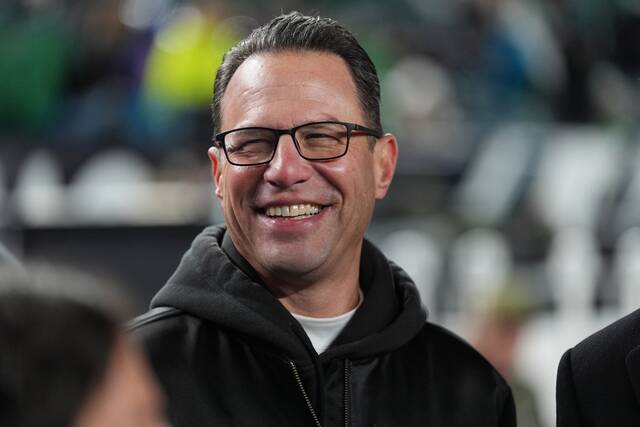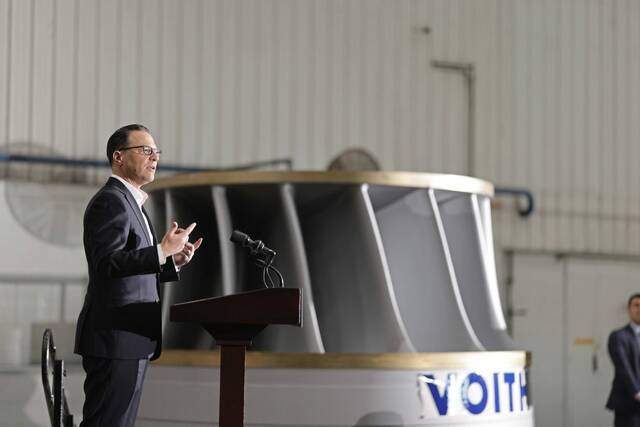The Pennsylvania House of Representatives spent nearly $500,000 to allow it to do more of what government does a lot: hold meetings.
That money was used to renovate two old courtrooms that had been sitting vacant for over a decade and transform them into large meeting rooms to accommodate more than two dozen House committees.
While spending that money at a time when Pennsylvanians are hurting from the pandemic may raise some eyebrows, even fiscal conservatives such as House Speaker Bryan Cutler, R-Lancaster County, finds it to be money well spent.
For one thing, it came in at half the anticipated cost. Originally, the makeover of the old courtrooms located on the fifth floor in the Irvis Office Building that adjoins the Capitol was expected to cost $1 million.
For another, the need was there, Cutler said. Meeting rooms for House committees are at a premium, particularly during the spring. The chamber had five serviceable meetings rooms available and committee chairmen fought for them to hold meetings and hearings. Now the House has seven rooms.
For both those reasons, Cutler said, “Leaving that space unused when we had it would have been wasteful on our part.”
Both renovated rooms are American Disabilities Act-accessible, equipped for remote participation by members and testifiers, and allow all committee members to have a seat at the desk. Cutler predicts they will become the most popular with committee chairmen for years to come.
On Monday, the meeting rooms — Room 515 IOB and Room 523 IOB — will be put to use for the first time by the House Professional Licensure Committee and the House Aging and Older Adult Services Committees.
Trimming the cost
The House gained control of the mothballed courtrooms after the Commonwealth Court vacated them in 2009 when it moved down Commonwealth Avenue to the Judicial Center. But the rooms were thought to be unusable.
House Chief Clerk Dave Reddecliff said they had been told there was a lot of asbestos in the ceilings. Besides that, the courtroom’s vertical design with a desk in the front to accommodate a three-to-five judge panel didn’t make them suitable for a meeting of a 25-member committee.
So the rooms sat idle for a decade and were used for storage.
When the decision was made to transform the space, Reddecliff, who oversaw the renovation along with Kevin Smith, the chamber’s facilities project coordinator, said they turned to the Department of General Services to handle the bulk of the work to save money.
General Services designers came up with a new configuration for the rooms, going with a horizontal design enabling each room to have a long desk to accommodate committee members. General Services employees cleared out the trappings of the old courtroom and performed the painting and other work.
In planning the project’s budget, Reddecliff said they anticipated one of the more expensive parts would be the asbestos removal. They figured that would run as high as $200,000. Turns out, Reddecliff said the bill from the contractor came in at $32,400 “so that was a huge savings right there.”
They cut costs on furniture. Initially, Reddecliff said the plan was to buy a desk that could accommodate 29 people (25 representatives and four staffers). That proved exorbitant, running into the hundreds of thousands of dollars.
“I couldn’t justify it,” Reddecliff said. “I kept going around and around so ultimately, [General Services] built it for us out of 2 by 6 and plywood. That was one of the ways we were able to reduce our cost tremendously.”
The finished product (which cost $12,097 to construct) was an expansive cherry-stained desk that runs the length of one wall and a smaller desk at each end. The desks are wired to provide an outlet and USB ports for internet connections at each member’s place.
General Services also built the platforms (at a cost of $6,538) on which the desks sit, ramps with railings, and covers for the heating and ventilation system.
“The great thing about these two rooms — and this is the thing I’m excited about — it’s the first of our seven meeting rooms that all 25 members of the committee will have their own seat at the desk,” Reddecliff said. “In all the other rooms, if a member gets there late, you might be sitting out in the audience. You might sit with the testifiers. You might be sitting in front of your fellow members. Here we have room for 29 people at the desk.”
The project’s biggest expense — more than half of the $445,487 cost - was for the technology to equip each room with 360-degree ceiling cameras, microphones, internet access, speakers, six large screen televisions in each room and broadcasting equipment so meetings can be live-streamed and transmitted to PCN.
To cut costs, Reddecliff went with pulldown blinds instead of more expensive window treatments.
They also got a better price on the chairs by buying a large quantity for both rooms — each of which can seat up to about 70 people — plus some for a nearby overflow room that can accommodate 20 to 24 people with a large screen TV. Total cost for the chairs: $71,240.
As for wall decorations, Reddecliff turned to the House Archives. He found an assortment of mementoes that former members and House employees had turned over — framed pens from bill signings, signs that marked members’ reserved parking spaces, a gold record given to former state Rep. Dwight Evans, framed photos, and more. Total cost: $0.
“They don’t call me the ‘Cheap Clerk’ for no reason,” Reddecliff said. “I said here’s a good way to decorate these walls.”
The plan is to change the wall displays in the meeting rooms and in the hallway between them every two years in between legislative sessions. He said his only rule about what gets displayed is the items have to be evenly split between Republicans and Democrats.
Need for space
Rep. Dave Hickernell, R-Lancaster County, is among the committee chairmen who had problems reserving a room over the years.
“Everybody seems to want to schedule committee meetings at the same time,” Hickernell said. “I knew these rooms were coming on line for the last year so I’m really excited. That gives us more opportunity to schedule committee meetings.”
Hickernell, as professional licensure committee chairman, will be the first to hold a hearing in one of the new rooms. He is impressed with how spacious they are and with the technology to allow for remote participation.
Other committee chairmen have complained about having to call impromptu committee meetings during breaks in the House session because all the meeting rooms had been booked before session started. If one of those meetings go long, it causes a disruption since the House can’t come back into session until the meeting concludes.
“We have the responsibility to have our committee meetings in spaces that are accessible to the public and that folks can come in and witness government in action,” Hickernell said. “That’s all part of the process. Having adequate meeting space available for committee meetings is essential. Unfortunately, we just haven’t had that. I think this is a positive step forward.”
Both he and Cutler are conscious of the price tag but with the cost ending up 50% less than expected, it’s easier to swallow.
“I do think they were necessary given the challenges between covid and balancing limited access [to the Capitol which has been closed to the public for much of the past year] with transparency,” Cutler said. “The space that was used was space that was vacated by courts leaving and the clerk I think did a wonderful job in terms of bringing it in under budget.”
Throughout the 18-month project, Reddecliff said he kept the majority and minority leaders apprised of the cost. He said he never heard a complaint.
“It’s not like we were building a sauna or something frivolous up here,” Reddecliff said. “These are rooms that as long as I’ve been here there’s always been a need for more committee space. And it does seem like committees over the last decade or so have become more active. So we need the proper space.”
The money to pay for this project came out of the House Chief Clerk’s budget for purchasing and maintenance. Reddecliff said spreading the project across two fiscal years and keeping it under budget made it more manageable.








